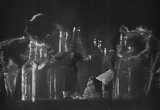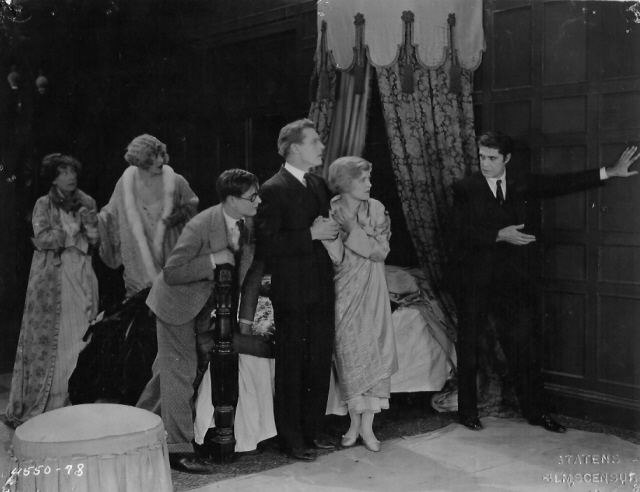Cat and the Canary (1927)
(I have included Chapter 4 from my unpublished book, German Expressionism and The Cat and the Canary.)
Leni and Karl Freund are the bridge between German Expressionism and American Expressionism. Freund was an art and film director on such films as The Golem (1920) and Metropolis (1927). He brought the distinct look of Expressionism to Dracula (1931) and The Mummy (1932).
Leni influenced Arthur Edeson, who was the cinematographer for Frankenstein (1931), The Old Dark House (1932) and The Invisible Man (1933). German Expressionism resulted in these films distinct Gothic look.
The Cat and the Canary (1927) (affiliate link) created the distinct Gothic look copied in so many of these other films. The key to understanding the mise-en-scene of the Universal horror films is The Cat and the Canary.

The Cat and the Canary poster from 1927
Released on September 9, 1927, the stars of the movie are Laura LaPlante, Creighton Hale, Tully Marshall, and Arthur Edmund Carewe. They are potential heirs to Cyrus West’s fortune. Cyrus left a will that the executor would read twenty years after his death.
Leni opens the film with an intertitle. “On a lonely, pine-clad hill overlooking the Hudson, stood the grotesque mansion of an eccentric millionaire…” The Gothic mansion has peaked spires and slanting walls leading to its ominous appearance.
Leni imposes an image of Cyrus West sitting in his chair in the middle of the mansion, which dwarfs West. The spires then dissolve into bottles surrounding West. The inter-title reads, “Medicine could do nothing for Cyrus West, whose greedy relatives, like cats around a canary, had brought him to the verge of madness…”
Leni imposes black cats around the bottles. West futilely swings at the cats before falling back into his chair. The constant pressure caused West’s heart to give out. Leni again shows us an establishing shot of the mansion with a clawed hand examining the will.
For the next twenty years, a housekeeper takes care of the mansion, while the heirs bide their time. The housekeeper believes Cyrus West’s ghost walks the halls.
On the night the lawyer is to read the will, Leni uses an intertitle to tell the viewer, “Something more tangible than a ghost walked the halls this night.” Leni uses a tracking shot of the interior of the mansion as seen by a flashlight to reveal the interloper who opens the safe and examines the will.
The executor arrives for the reading of the will. He clears cobwebs away from the handle on the front door. No one has opened the door for twenty years as the housekeeper would use the servant’s entrance. Leni shows the artist touch with this attention to detail.

Still from The Cat and Canary (1927)
When the executor opens the safe, he is shocked. A moth flies out of the safe. The executor turns to the housekeeper and asks how a moth could live in a safe for twenty years. The housekeeper claims it is the work of Cyrus West’s ghost. Leni uses a tracking shot through the first floor of the mansion to both set up the space and imitate the effect of a ghost walking the halls of the spacious mansion. (This technique is not part of mise-en-scene.)
After he finds the moth, the executor checks the envelopes and realizes someone opened the letters. The executor demands to know who has been in the mansion. The housekeeper states only me and the ghost.
The heirs slowly arrive on this dark, wind-blown night. The first guest is Cyrus West’s nephew Harry Blythe, played by Arthur Edmund Carewe. Harry’s cousin Charlie Wilder, played by Forrest Stanley, joins Harry and the lawyer.
Harry refuses Charlie’s offer of a handshake at first because of an unspoken family grudge. At the executor’s prodding, Harry finally shakes Charlie’s hand as they smile warily.
West’s sister Susan and her niece Cecily arrive next. The taxi drivers will drop them in front of the house but will not drive into the driveway because of “ghosts.” The wind keeps blowing open the door and fluttering the curtains.
Leni uses the set design of the mansion, which he sparsely furnishes, to set up an old, dusty, and poorly lit “an old dark house” setting. Except for the library and the bedrooms, most rooms and hallways are absent of furniture making the house seem much bigger than the figures occupying it. The mansion has a chilling effect on Susan and Cecily.
Paul Jones is the last male cousin to arrive. Creighton Hale plays the mousy Jones, who thinks his tire blowing out is someone shooting at him. He perks up when the last heir, Annabelle West, arrives.

The Mysterious Hand from The Cat and the Canary – Courtesy of the Creative Commons
The heirs all arrive, and the clock begins to chime at midnight. Leni interposes the inside of the clock and the chimes over the shot of the table, where the executor will read the last will and testament of Cyrus West. The clock chimes as everyone begins to take their seats at the table.
Cyrus’ will retell his grievances against his relatives. He leaves his entire estate to his most distant relation, Annabelle West. The housekeeper produces another note for Annabelle from Cyrus. He wants her to read it in Cyrus’ old room.
Laura LaPlante played Annabelle West. Leni liked LaPlante as his lead and would cast her in his last film, The Last Warning (1929).
The will aggravates the heirs, who claim Cyrus’ insanity led to his choice of Annabelle. As Annabelle’s aunt is speaking, Cyrus’ picture falls from the wall further sparking speculation about “the ghost” and portending an eventful night in the house.
The picture falling unnerves Annabelle, who asks the guests to have something to drink before bed. As all the other family members retire to the other room to eat, Annabelle meets with the executor. Leni shoots Annabelle through the slats in a chair to simulate the bars on a cage in a scene reminiscent of the opening of her uncle surrounded by the cats. The executor tells Annabelle that she is just like her Uncle Cyrus.
He also tells her that if a doctor does not certify her sanity, another family member will inherit the fortune. The other heir already read the letters. As the executor Mr. Crosby is getting ready to reveal the name of the relative, a mysterious clawed hand reaches out and drags him back into a hidden passage behind a bookcase.
Annabelle runs from the room and tells her family what happened, but they do not believe her. They think she is as mad as Cyrus West. Leni uses a close-up to illustrate the strain that the events are putting on Annabelle. It is the first hint the other heir is trying to drive her crazy.
While Annabelle and the other guests are readying for bed, a caretaker from the local asylum enters the house looking for an escaped patient. He tells them to beware the mad man, who will tear them to pieces. Directors used this plot device often in the late 1920s and early 1930s in films including the “B” film, The Ghost Walks (1934).

Still from The Cat and the Canary (1927)
The family retires for the night and exits the dining room through an arched doorway. Leni uses the arched doorway in scenes to emphasize the film’s Gothic look. Leni used arches on doorways and fireplaces throughout the film, a common set technique in Expressionistic films.
When Annabelle enters her uncle’s room, she reads the letter. It leads her to a false compartment in the fireplace, where she finds an expensive necklace, the West Diamonds. Annabelle retires wearing the necklace in a bed no one had slept in since the death of Cyrus West.
While Annabelle is sleeping, a panel opens behind her bed. A hairy, clawed hand appears from the paneling. After making a couple hand opening gestures to emphasize the size and potential deadliness of the claws, the hand snatches the necklace and disappears back into the paneling. Annabelle screams for help which summons her family members.
Harry and Charlie, appear from the upstairs wearing overcoats leading the viewer to suspect them. The other three potential heirs were together and could not have been involved in the theft.
At first, the family does not believe Annabelle, who pushes a piece of the paneling in to reveal the hidden door. When the door opens, the executor of the will falls into the room dead. Cousin Harry, who suspects the escaped patient is responsible, says he will go for the guard.
Charlie says he will go for the police, but the housekeeper interrupts him. She says she will go for the police. Harry and Charlie, who obviously suspect each other, lurk around the mansion.
Paul Jones goes with Annabelle back to her room to retrieve the paper from the lawyer’s pocket. Paul believes that the other heir’s name will solve the mystery. However, the murderer removes the lawyer’s body. Paul enters the hidden passage in the wall, which closes behind him.
While Annabelle is trying to reopen the panel, a doctor straight out of The Cabinet of Dr. Caligari (1929) arrives to examine Annabelle. The doctor is slightly balding, wearing round spectacles and dressed in all black. Leni uses frequent close-ups to emphasize the cadaverous look of the doctor’s face to make him look more like a mental health patient than a psychiatrist giving a sanity test.
After Annabelle meets with the psychiatrist, the sanitarium guard reenters the house and asks if he heard correctly that an unknown killer was running loose. When Annabelle nods, he slowly backs out of the room.
Paul meets the bad guy in the basement and tackles him. The masked fiend is desperate to get upstairs to Annabelle as the police race to the house. The formerly wimpy Paul inspired by his obvious love for Annabelle fights the man like a tiger.
The man overcomes Paul momentarily and menaces Annabelle in the library, but Paul quickly regains his senses. Paul attacks the man again and a desperate struggle ensues.
The guard walks in but flees instead of helping Paul, who is restraining the masked man. Harry alerted to the commotion chases the guard and prevents his escape as the police arrive.
The police take custody of both men. The fiend is Cousin Charlie, who would be the heir if the doctor judged Annabelle mentally unwell. Charlie hired a fake guard to help unbalance Annabelle before the arrival of the psychiatrist.
As the police take the men to jail, Annabelle tells Paul she is in love with him. The film ends with them sitting in a large chair together discussing their future.
Leni’s use of sparsely furnished large dark rooms, arched doorways and costuming of the fiend all led to the Gothic look of the film. The arched doorways, sparse furnishings and large mansion created an ominous atmosphere where structure dominates the characters.
Leni’s set design kept the suspense high by cueing the viewer to expect a trap door, false wall, or clawed hand to pop at any time. The clawed hand and mask on Charlie were important to inspire terror. Set design and costuming create the unique look copied in later films.
Edeson used these same techniques in Frankenstein (1931). Edeson’s did excellent work, but one cannot help wondering how Leni’s eye for detail would have influenced the films.
Leni’s next film would be The Chinese Parrot (1927). Tragically, this film is lost. Released seven weeks after The Cat and the Canary on October 23, 1927, The Chinese Parrot starred Japanese actor Sojin Kamiyama as Inspector Chan. The loss of Leni’s treatment of the first film adaptation of the Charlie Chan series is tragic.
Fortunately, Leni made two more films before his tragic death in 1929. The Man Who Laughs (1928), and The Last Warning (1929) are classics.
Pin It
